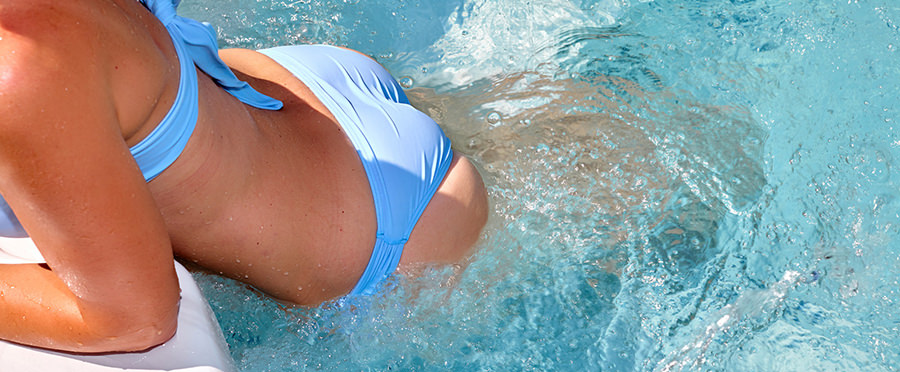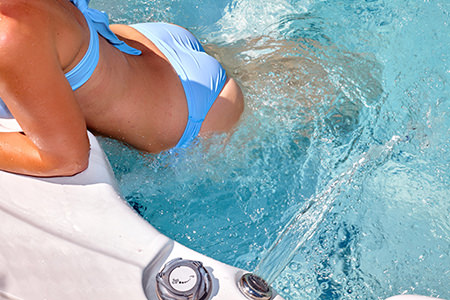
You probably already know that you need to shock dose your hot tub regularly to keep the water clear fresh and healthy. However, did you know that you can shock your hot tub with both chlorine and non-chlorine shock? Many hot tub owners these days are looking for a more natural and less chemical-based solution to their sanitization. So is shocking with a non-chlorine shock a good idea? Is it possible just to use a non-chlorine shock, or do both of them need to be combined? I decided to do some research into the differences between chlorine and non-chlorine hot tub shock, and this is what I found out:
What does shocking your hot tub mean?
Shocking your hot tub means that you give it a quick super dose of sanitization chemical. Very often, this will clear up any problems with cloudy or foamy water fairly much instantly and will also revitalize your main sanitizer such as chlorine or bromine, and help them to work more effectively. It’s a good idea to shock your hot tub after every water change to make sure that you are getting a good clean start and that the water is free from contaminants. Going forward, shocking the tub should also be part of your regular maintenance routine and, depending on how much you use your hot tub gets, you will need to shock it on a daily or at least weekly basis.
What types of hot tub shock are there?:
Chlorine shock – this is also known as Dichlor, and it’s compatible with bromine sanitizers as well as chlorine sanitizers and can be used with several other sanitization methods such as UV, ozonators, and saltwater. Dichlor, or chlorine shock, is really a super sanitizer, and this is the shock treatment that you should use in every hot tub immediately after filling to make sure that the freshwater is as clean and sanitary as can be. Dichlor is also excellent at clearing up water problems such as cloudy or smelly water and will often do this fairly much instantly once it is added to the hot tub. You might also need to use a shock dose of chlorine shock every week to make sure that your sanitization levels are kept correct, and a full chlorine shock might need to be used after your hot tub has had a significantly long period of usage.

Non-chlorine shock – this is often known as MPS, and again, it generally has full compatibility with both chlorine and bromine sanitizers as well as the alternative sanitizer as mentioned above. Non-chlorine shock doesn’t actually sanitize the water but is fantastic at helping out with clarity problems as it oxidizes contaminants quickly and efficiently. You can use a non-chlorine shock essentially as often as you want; many people use it daily or even after each hot tub session.
How to shock your hot tub
Whichever type of shock you were using, it’s a good idea to shock your hot tub after use rather than just before getting into it. If you are using a chlorine shock, you will need to leave it for several hours for the chlorine levels to dissipate before it is safe to get in your hot tub; you could suffer skin irritation and breathing difficulties if the chlorine levels are too high. You can, in theory at least get straight into a hot tub after shocking it with MPS or non-chlorine shock, but personally, I would give it some time before getting in just to be on the safe side. So, as a rule of thumb, it’s a good idea to always shock after used so that the hot tub has time to recover before you get into it again.
You will be able to work out how much shocking compound to add to the water by looking on the side of the packet. Take care to use the right quantity and bear in mind that the compound may blow into your face as you scatter it over the water. So, try to stand with the wind in the right direction so that it will be blown into the hot tub and also have the pumps running so that the water is circulating and the shock compound is dissolved evenly throughout the body of the water. Once you have added the shock treatment, leave the lid of the hot tub off, so that the chemical vapors can dissipate.

It’s also worth adding that there is little point in using a shock treatment in your hot tub if your pH levels are incorrect. As part of your regular daily maintenance schedule, you should check that your pH level is ok and correct it if necessary. Neither of your chemical sanitizer or any shock treatments that you use will work effectively if your pH level is incorrect.
Should I use chlorine or non-chlorine shock in my hot tub?
So the answer to the question really is that you can use both chlorine and non-chlorine shock in your hot tub. The chlorine or Dichlor shock needs to be used to sort out problems when you first put the water into the hot tub and also every week to make sure that your sanitization levels are correct. Even if you are using an alternative sanitization method such as saltwater, UV, or ozonation, you will, unfortunately, need to use a chlorine shock every so often to make sure that your water is sanitary.
However, if you are careful and you keep the water as clean as possible, shower before entering the hot tub, maintain the correct pH levels, and keep your lid on your hot tub, you will hopefully be able to use a non-chlorine shock for much of the time. A non-chlorine shock can be used for regular maintenance and should be used daily after each session when the hot tub is used. This will help to make sure that the water stays clean and fresh. However, remember that a non-chlorine shock is not a sanitizer, so do not rely on it for your sanitization.
What is the correct chlorine level for a hot tub?
It’s imperative that you test your chlorine levels regularly using test strips to make sure that they do not get too high or drop too low. If your chlorine level is too high, then you could suffer skin irritation and breathing difficulties, and if it is too low, you will be risking bacteria and algae growing in your hot tub. When you first shock your hot tub with a chlorine shock and first sanitize your water with chlorine, the chlorine levels should be as high as around eight parts per million. However, it’s not safe to get into a hot tub unless the levels of chlorine are between 3 and 5 parts per million.
With the high chlorine level, the chlorine will quickly super sanitize your water, and the high level is necessary occasionally to make sure that everything is clean and fresh. The only way to reduce your chlorine level is to wait for it to dissipate. This may take several hours or even overnight, so it’s important if you are shocking your hot tub with a chlorine shock to allow plenty of time before using your hot tub again.
Can I avoid using chlorine in my hot tub?
Many people have moved towards using more natural methods of sanitization in recent years and do not like the thought of adding strong chemicals to the hot tub water. At the very least, chlorine shock should be used to get a good clean start after refilling the hot tub, which you may well be able to rely on an alternative sanitization system. However, in reality, nothing is as effective as chlorine in killing germs and bacteria, so you will need to be scrupulously clean when using your hot tub and make sure that you keep up with your regular water maintenance. If you do this, then you may well be able to manage just by using non-chlorine shock.
However, do bear in mind that your health is at stake if your water does become infected and that if you do use a chlorine shock, then it does dissipate quite quickly and leave the water relatively chlorine-free. So, if your hot tub is just used by a couple of adults two or three times a week then you are unlikely to have any major problems with your water sanitization. However, if you regularly have different people’s children, older people, friends, relatives, and a heavy bather load for your hot tub then you might struggle without using chlorine shock to keep it clean and hygienic.

